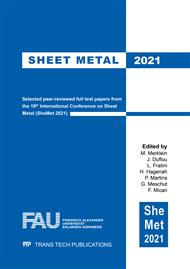[1]
G. Meschut, V. Janzen, T. Olfermann, Innovative and Highly Productive Joining Technologies for Multi-Material Lightweight Car Body Structures, J. Mater. Eng. Perform. 23 (2014) 1515-1523.
DOI: 10.1007/s11665-014-0962-3
Google Scholar
[2]
X. He, Clinching for sheet materials, Sci. Technol. Adv. Mater. 18 (2017) 381-405.
Google Scholar
[3]
L. Calabrese, E. Proverbio, G. Galtieri, C. Borsellino, Effect of corrosion degradation on failure mechanisms of aluminium/steel clinched joints, Mater. Des. 87 (2015) 473-481.
DOI: 10.1016/j.matdes.2015.08.053
Google Scholar
[4]
R. Neugebauer, R. Mauermann, R. Grützner, Einfluss von kombinierter mechanisch-medialer Beanspruchung auf die Schwingfestigkeit von stanz- und blindgenieteten Mischverbindungen. EFB-Verlag, Hannover, (2012).
Google Scholar
[5]
M. Wang, G. Xiao, Z. Li, J. Wang, Shape optimization methodology of clinching tools based on Bezier curve, Int. J. Adv. Manuf. Technol. 94 (2018) 2267-2280.
DOI: 10.1007/s00170-017-0987-5
Google Scholar
[6]
A.-B. Ryberg, L. Nilsson, Spot weld reduction methods for automotive structures. Struct Multidisc Optim 53 (2016) 923-934.
DOI: 10.1007/s00158-015-1355-4
Google Scholar
[7]
D.W. Kelly, M. Elsley, A procedure for determining load paths in elastic continua, Eng. Comput. 12 (1995) 415-424.
DOI: 10.1108/02644409510799721
Google Scholar
[8]
K. Marhadi, S. Venkataraman, Comparison of Quantitative and Qualitative Information Provided by Different Structural Load Path Definitions, Int. J. Simul. Multidiscip. Des. Optim. 3 (2009) 384-400.
DOI: 10.1051/ijsmdo/2009014
Google Scholar
[9]
C. Steinfelder, A. Brosius, A New Approach for the Evaluation of Component and Joint Loads Based on Load Path Analysis, in: BA. Behrens, A. Brosius, W. Hintze, S. Ihlenfeldt, J.P. Wulfsberg (Eds), Production at the leading edge of technology. WGP 2020. Lecture Notes in Production Engineering. Springer, Berlin, Heidelberg, 2021, p.134–141.
DOI: 10.1007/978-3-662-62138-7_14
Google Scholar
[10]
A. Lasia, General Model of Electrochemical Hydrogen Absorption into Metals, J. Electrochem. Soc. 142 (1995) 3393-3399.
DOI: 10.1149/1.2050267
Google Scholar
[11]
M. Mohamed-Said, B. Vuillemin, R. Oltra, A. Marion, L. Trenty, D. Crusset, Predictive modelling of the corrosion rate of carbon steel focusing on the effect of the precipitation of corrosion products," Corros. Eng. Sci. Technol. 52 (2017) 178-185.
DOI: 10.1080/1478422x.2017.1305651
Google Scholar
[12]
S. Sarkar, J. E. Warner, W. Aquino, A numerical framework for the modeling of corrosive dissolution, Corros. Sci. 65 (2012) 502-511.
DOI: 10.1016/j.corsci.2012.08.059
Google Scholar
[13]
M. Rossi, T. Wallmersperger, S. Neukamm, K. Padberg-Gehle, Modeling and Simulation of Electrochemical Cells under Applied Voltage, Electrochimica Acta 258 (2017) 241-254.
DOI: 10.1016/j.electacta.2017.10.047
Google Scholar
[14]
M. Rossi, T. Wallmersperger, Thermodynamically consistent three-dimensional electrochemical model for polymeric membranes, Electrochimica Acta, 283 (2018) 1323-1338.
DOI: 10.1016/j.electacta.2018.06.174
Google Scholar
[15]
Livermore LSTC: LS-DYNA R11 Keyword user's manual - Volume I. (r:10580) (2018).
Google Scholar
[16]
Livermore LSTC: LS-DYNA R11 Keyword user's manual - Volume II. (r:10850) (2019).
Google Scholar
[17]
K. B. Deshpande, Validated numerical modelling of galvanic corrosion for couples: Magnesium alloy (AE44)-mild steel and AE44-aluminium alloy (AA6063) in brine solution, Corros. Sci. 52 (2010) 3514-3522.
DOI: 10.1016/j.corsci.2010.06.031
Google Scholar
[18]
P. Doig, P. E. J. Flewitt, A Finite Difference Numerical Analysis of Galvanic Corrosion for Semi‐Infinite Linear Coplanar Electrodes, J. Electrochem. Soc. 126 (1979) 2057-2063.
DOI: 10.1149/1.2128861
Google Scholar


